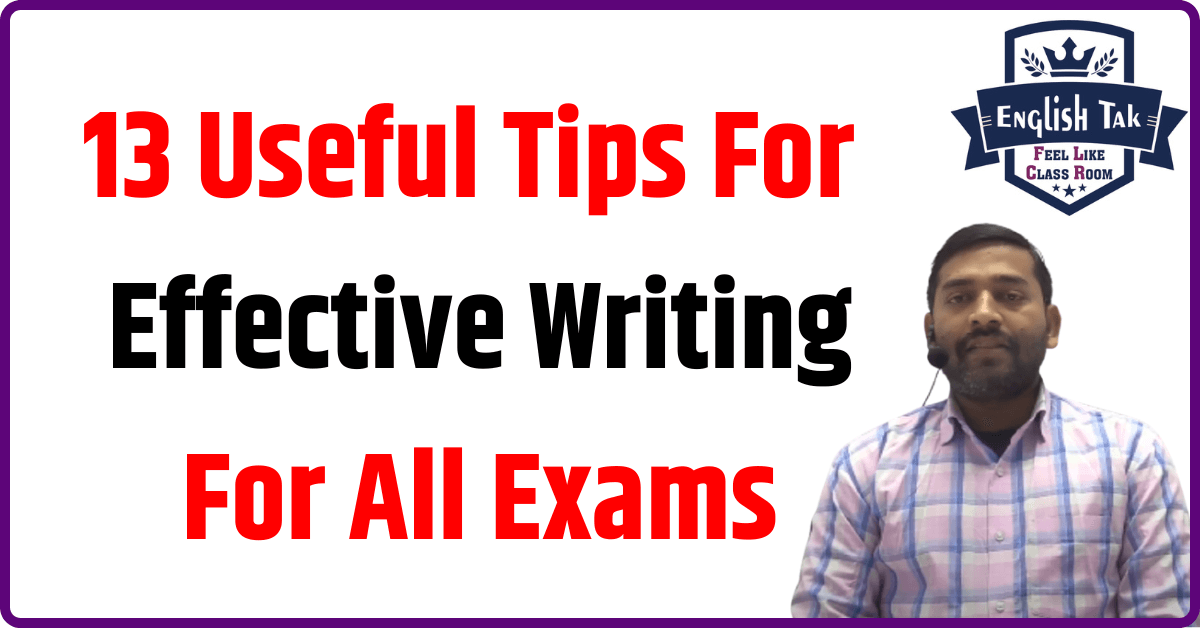![]()
Useful Tips For Effective Writing
In this post, You are going to learn very-very important Tips for effective writing. It will help you improve you writing skills. As you all know, Questions related to writing, are often asked in various academic exams as well as in some of the competitive exams. Here are some useful tips for effective writing. It is generally asked in CBSE Class 8th, CBSE Class 9th, CBSE Class 10th, CBSE Class 11th and CBSE Class 12th.
Click Here to Download the Pdf
1. Be Precise and CONCISE
Precise means clear and accurate and concise means giving only necessary and important information in a few words. Therefore, do not repeat ideas and words unless you need repetition to summarise your ideas or to emphasise them to keep your reader on track.
Precise का अर्थ है स्पष्ट और सटीक और concise का अर्थ है केवल आवश्यक और महत्वपूर्ण जानकारी को कुछ शब्दों में देना। इसलिए, विचारों और शब्दों को तब तक न दोहराएं जब तक आपको अपने विचारों को संक्षेप में प्रस्तुत करने के लिए या अपने पाठक को ट्रैक पर रखने के लिए उन पर जोर देने की आवश्यकता न हो।
2. Use PARAGRAPHS
Except in questions which are to be answered in one paragraph only, use several paragraphs each having only one main idea / point or argument that is stated in what is called a topic sentence. The other sentence either expand the idea or point being made or supported contradict an argument.
केवल एक पैराग्राफ में उत्तर दिए जाने वाले प्रश्नों को छोड़कर, कई पैराग्राफों का उपयोग करें जिनमें से प्रत्येक में केवल एक मुख्य विचार / बिंदु या तर्क हो, जिसे विषय वाक्य कहा जाता है। अन्य वाक्य या तो विचार का विस्तार करते हैं या बनाए जा रहे बिंदु या समर्थित तर्क का खंडन करते हैं।
3. Show PROGRESSION
What you write should have a beginning, a middle and an end or conclusion. The string of paragraphs you use should show this progression. Within a single paragraph, too, ideas should proceed from or lead to its main idea.
आप जो लिखते हैं उसका आरंभ, मध्य और अंत या निष्कर्ष होना चाहिए। आपके द्वारा उपयोग किए जाने वाले पैराग्राफ की स्ट्रिंग को यह प्रगति दिखानी चाहिए। एक पैराग्राफ के भीतर भी, विचारों को अपने मुख्य विचार से आगे बढ़ना चाहिए या आगे बढ़ना चाहिए।
Suggested For You |
|
| Grammar | EnglishTak YouTube Channel |
| Spoken English | Videos |
| Ranjan Sir Blog | Join Our WhatsApp Group |
Useful Tips For Effective Writing
4. Include COHESIVE DEVICES
In order to have a logical organization or arrangement of ideas in a paragraph and across a complete piece of writing, use cohesive devices i.e. words or expresses that bring about unity and clarity in what you write
Useful Tips For Effective Writing
5. Cohesion can be achieved through
- Repetition of keyword/phrases in order to keep the reader on track
- Synonyms (instead of using the same word again and again) and antonyms
- Pronouns to avoid the repetition of nouns.
- Transitional words i.e. words indicating a change or shift in idea. (These words express concepts like addition, companion, contrast, enumeration, concession, exemplification, inference, summary/conclusion, time and sequence, result, reformulation, replacement and place/position. Adverbial words and phrases also fall under this category)
- Collocations words that are commonly paired together
- Repeated or parallel sentence patterns for emphasis or rhetorical effect
एक तार्किक संगठन या एक पैराग्राफ में और पूरे लेखन में विचारों की व्यवस्था करने के लिए, आप जो लिखते हैं उसमें एकता और स्पष्टता लाने वाले शब्दों या अभिव्यक्तियों का उपयोग करें।
सामंजस्य के माध्यम से प्राप्त किया जा सकता है
- पाठक को ट्रैक पर रखने के लिए कीवर्ड/वाक्यांशों की पुनरावृत्ति
- समानार्थी शब्द (एक ही शब्द का बार-बार उपयोग करने के बजाय) और विलोम शब्द
- सर्वनाम संज्ञाओं की पुनरावृत्ति से बचने के लिए।
- संक्रमणकालीन शब्द यानी विचार में बदलाव या बदलाव का संकेत देने वाले शब्द। (ये शब्द जोड़, साथी, विपरीत, गणना, रियायत, उदाहरण, अनुमान, सारांश/निष्कर्ष, समय और अनुक्रम, परिणाम, सुधार, प्रतिस्थापन और स्थान/स्थिति जैसी अवधारणाओं को व्यक्त करते हैं। क्रियाविशेषण शब्द और वाक्यांश भी इस श्रेणी के अंतर्गत आते हैं)
- कोलोकेशन शब्द जो आमतौर पर एक साथ जोड़े जाते हैं
- जोर या अलंकारिक प्रभाव के लिए दोहराए गए या समानांतर वाक्य पैटर्न
6. Read the RUBRICS
Read the action statement carefully inducing the bullet points, if any, to decide the context, contents and style of your writing. This will help you to complete the task according to the requirements of the question, including the word limit.
अपने लेखन के संदर्भ, सामग्री और शैली को तय करने के लिए, यदि कोई हो, तो बुलेट बिंदुओं को प्रेरित करते हुए कार्रवाई विवरण को ध्यान से पढ़ें। इससे आपको शब्द सीमा सहित प्रश्न की आवश्यकताओं के अनुसार कार्य को पूरा करने में मदद मिलेगी।
7. Employ Appropriate VOCABULARY
The vocabulary, you use, should be appropriate to the task. The more complex, idiomatic and accurate your vocabulary is, the higher marks you can get, provided you take care to avoid spelling errors.
आपके द्वारा उपयोग की जाने वाली शब्दावली कार्य के लिए उपयुक्त होनी चाहिए। आपकी शब्दावली जितनी अधिक जटिल, मुहावरेदार और सटीक होगी, आप उतने ही अधिक अंक प्राप्त कर सकते हैं, बशर्ते आप वर्तनी की त्रुटियों से बचने के लिए सावधानी बरतें।
8. Avoid GRAMMATICAL ERRORS
As in vocabulary, the more complex and accurate the grammatical structures you employ, the better your score will be. Therefore, use a mix of simple and complex structures. Also make sure that you use punctuation marks consistently and accurately
शब्दावली के रूप में, आप जितने अधिक जटिल और सटीक व्याकरणिक संरचना का उपयोग करेंगे, आपका स्कोर उतना ही बेहतर होगा। इसलिए, सरल और जटिल संरचनाओं के मिश्रण का उपयोग करें। यह भी सुनिश्चित करें कि आप विराम चिह्नों का लगातार और सटीक रूप से उपयोग करते हैं।
9. Choose an Appropriate STYLE AND FORMAT
Depending upon your target audience and the situation or context in which you are writing, vary your style and tone from formal to informal and from impersonal to personal. An academic piece of writing, example, should differ in style from a personal letter. A newspaper article should read like an article and a speech should sound as a speech. And the way you would write to a friend or relative is certainly different from the way you would write to an editor or a government official.
अपने लक्षित दर्शकों और उस स्थिति या संदर्भ के आधार पर जिसमें आप लिख रहे हैं, अपनी शैली और स्वर को औपचारिक से अनौपचारिक और अवैयक्तिक से व्यक्तिगत में बदल दें। लेखन का एक अकादमिक टुकड़ा, उदाहरण, व्यक्तिगत पत्र से शैली में भिन्न होना चाहिए। एक अखबार के लेख को एक लेख की तरह पढ़ना चाहिए और एक भाषण को भाषण के रूप में पढ़ना चाहिए। और जिस तरह से आप किसी मित्र या रिश्तेदार को लिखते हैं, वह निश्चित रूप से एक संपादक या सरकारी अधिकारी को लिखने के तरीके से अलग होता है।
10. Respect the WORD LIMIT
If your answer falls short of the word limit, it is probably incomplete or does not fulfil the requirements of the question and if it overshoots the world limit it is either not to the point or full of repetition and/or unnecessary ideas. Learn to respect the word limit.
यदि आपका उत्तर शब्द सीमा से कम है, तो यह शायद अधूरा है या प्रश्न की आवश्यकताओं को पूरा नहीं करता है और यदि यह दुनिया की सीमा को पार कर जाता है तो यह या तो बिंदु पर नहीं है या दोहराव और/या अनावश्यक विचारों से भरा है। शब्द सीमा का सम्मान करना सीखें।
11. Plan BEFORE YOU WRITE
Only very gifted writers can write offhand and yet be effective. As a student writer you need to plan in detail before your write. It is a good idea to brainstorm a topic and note down as many ideas as come to mind and later select only the most relevant among them.
केवल बहुत प्रतिभाशाली लेखक ही ऑफहैंड लिख सकते हैं और फिर भी प्रभावी हो सकते हैं। एक छात्र लेखक के रूप में आपको अपने लेखन से पहले विस्तार से योजना बनानी होगी। किसी विषय पर विचार-मंथन करना और मन में जितने विचार आते हैं उन्हें नोट करना और बाद में उनमें से केवल सबसे प्रासंगिक का चयन करना एक अच्छा विचार है।
12. Read and PRACTICE A LOT
Unless you read a lot, you will find it hard to generate ideas and have the necessary information on the topic, you have to write and if you do not practise writing you may not know what your strengths and weaknesses as a writer are and how you can build on the former and eliminate the latter.
जब तक आप बहुत कुछ नहीं पढ़ते हैं, आपको विचारों को उत्पन्न करने और विषय पर आवश्यक जानकारी प्राप्त करने में मुश्किल होगी, आपको लिखना होगा और यदि आप लिखने का अभ्यास नहीं करते हैं तो आप नहीं जान सकते कि एक लेखक के रूप में आपकी ताकत और कमजोरियां क्या हैं और आप कैसे हैं पूर्व पर निर्माण कर सकते हैं और बाद वाले को समाप्त कर सकते हैं।
13. Edit and REVISE YOUR DRAFT
Once you have prepared the first draft, edit and revise it to remove any unnecessary repetition and errors in spelling, vocabulary, punctuation and grammar as well as to ensure that there is a clear progression from the beginning to the end and that the ideas are relevant and logically organised.
एक बार जब आप पहला मसौदा तैयार कर लेते हैं, तो वर्तनी, शब्दावली, विराम चिह्न और व्याकरण में किसी भी अनावश्यक पुनरावृत्ति और त्रुटियों को दूर करने के साथ-साथ यह सुनिश्चित करने के लिए कि शुरुआत से अंत तक एक स्पष्ट प्रगति है और विचार प्रासंगिक हैं, इसे संपादित और संशोधित करें। और तार्किक रूप से व्यवस्थित।





